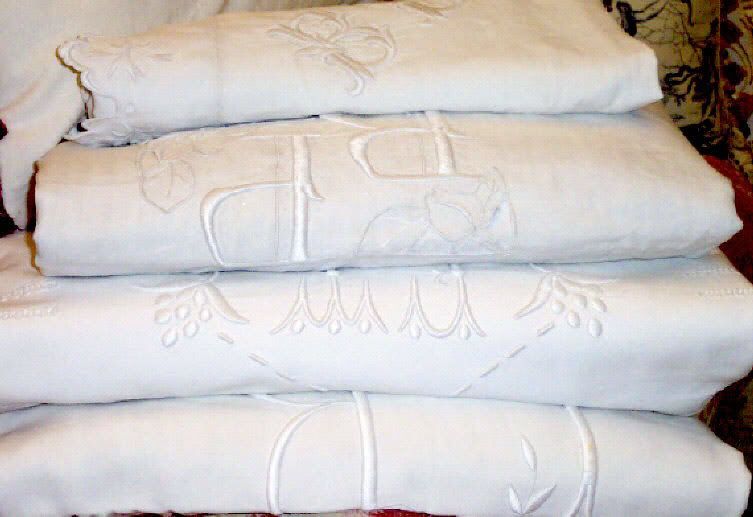
Generally, I find monograms to be in rather poor taste. It's something about the Lilian Vernon "get it monogrammed for two dollars extra" mindset that seems terribly tacky.
That being said, I adore the artful monograms that graced linens in the past. I remember reading about them in Miss Manners' as a kid and I was totally enthralled by the notion of someday possessing my very own set of monogrammed linens.
The practice of applying monograms is over three hundred years old. Before the 1700's, monograms were strictly limited to the nobility, who added monograms for much the same reason that hotels include them today--for identification. Because there was no such thing as machine weaving at that time, fabrics were incredibly costly and were as significant a part of a noblewoman's dowry as land. Intricate hand made designs of the crest of the noble family were carefully applied to the linens.
By the 1700s, however, things were beginning to change. Members of the growing middle class wanted to emulate the habits of the nobility, and they begin copying the custom. Most did not possess family crests, so they began to embroider their own initials into the fabric instead. Embroidery techniques were quite elaborate at times and often included applique, cutwork and drawn work. In an effort to create a more "crest-like" image, elaborate floral borders were often added.
In spite of the numerous innovations in monograms over the years, one thing that remained unchanged until recently was the custom of working the embroidery in white thread on white or ivory linen. As you will have noticed, this is more of an exception to the rule these days...most monograms use strongly contrasting thread in order to highlight the initials.
So, what did the Pre-Raphaelites think of monograms? William Morris was certainly a fan--Red House is crowned with a weathervane formed out of Morris' initials. Morris was more a fan of crests, though, which makes sense given his admiration for the medieval.
One company that keeps the tradition of fine hand embroidery alive is D. Porthault of France. The company was the linen provider of choice for royals on both sides of the Atlantic--the Windsors and the Kennedy clan reportedly slept on nothing else. Their fine linens cost a pretty penny, however. A set of King sheets with pillow shams will set you back a mere $2800. Perhaps you could invest a little time in learning to do embroidery yourself!
Image courtesy Linge de Berry Bedlinens
Monday, February 11, 2008
The Artistic Monogram
Posted by
Margaret
at
9:13 AM
![]()
![]()
Labels: needlework
Subscribe to:
Post Comments (Atom)


4 comments:
I was only just reading last night about Hand and Lock - the oldest goldlace company in the world. They maintain exacting standards and state: 'any embroiderer worth their salt should be able to produce a perfect monogram'. easier said than done. I monogrammed something for a wedding gift in padded satin stitch - I won't be doing it for a living - its the sort of thing that the simpler it looks the harder it is to achieve a 'perfect' look.
I knew when I posted my items I would be instantly humbled! Your blog is amazing and well-written (and well-researched...history is a good field for you, I can tell!). Thank you for visiting my blog.
Kate
by the way, Sur La Lune is amazing. I've been looking at it for years. If I could just study folklore forever, I would!
I remember that as a child my mother would take us to the Lands End outlet store and we would buy the occasional monogrammed fare, but it was someone else monogram or some mistake they made at the factory.
I guess I'm thinking about monograms and the idea of the self. Is wearing another's initials or crest liberating? Is wearing your own monogram empowering?
Post a Comment